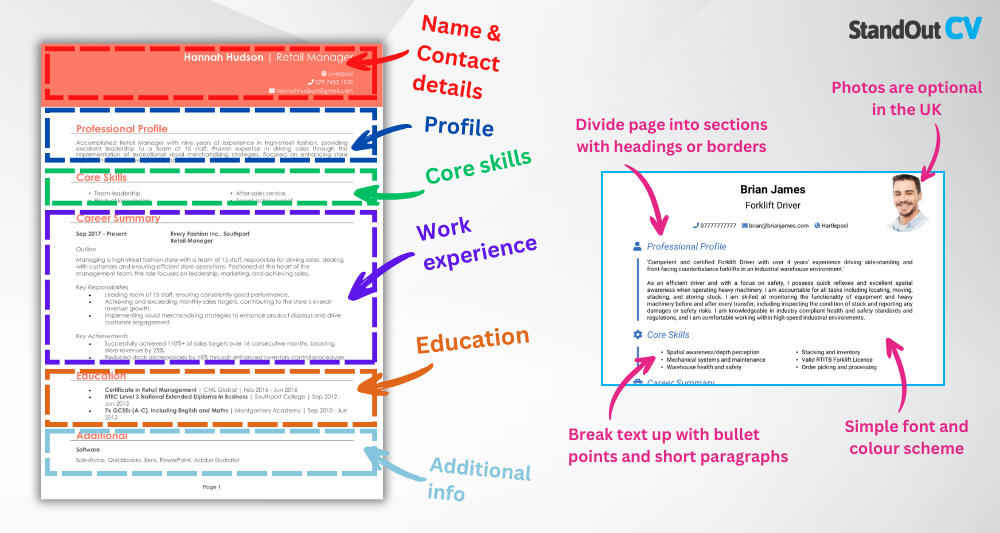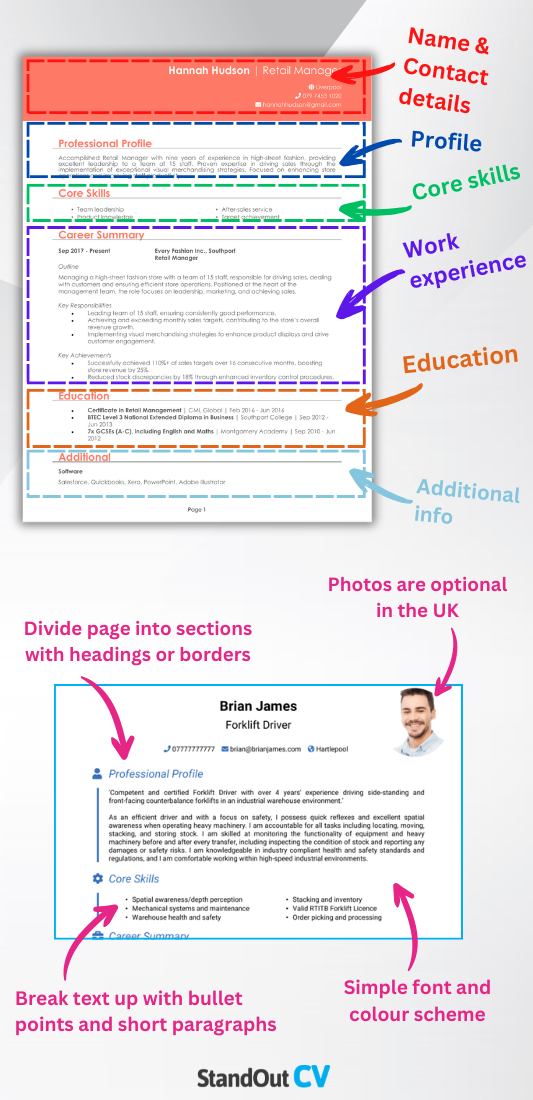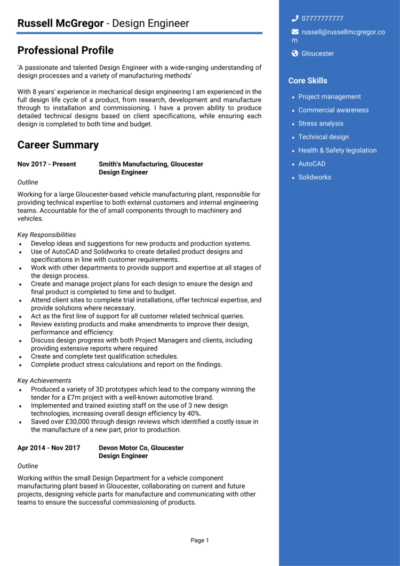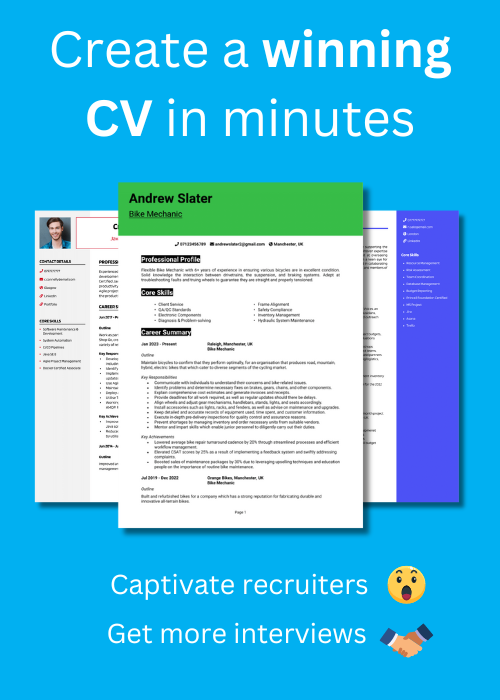Spending hours refining CAD models and perfecting tolerances? That’s your comfort zone. Writing a CV that clearly reflects that expertise? Not quite as straightforward.
If your CV doesn’t show how your designs translate into real-world performance, you risk being overlooked – even with brilliant ideas and project wins under your belt.
This guide and its Mechanical Design Engineer example CV will help you present your skills, experience, and technical knowledge with precision – so you can land the interviews your designs deserve.
Mechanical Design Engineer CV

How to write your Mechanical Design Engineer CV
Discover how to craft a winning Mechanical Design Engineer CV that lands interviews with this simple step-by-step guide.
Writing a CV as a mechanical design engineer is difficult: but this guide covers everything from presenting your technical strengths to communicating the value of your project experience.
Whether you’re designing components for aerospace or developing consumer products, you’ll learn how to tailor each section to showcase your impact, creativity, and attention to detail.
What’s the right way to structure and format your Mechanical Design Engineer CV?


Recruiters are busy, and if they open up a CV full of mistakes and sections impossible to navigate, they’re just going to move onto the next applicant. Design engineering is about accuracy and logical sequencing – and that same thinking should apply to your CV structure. A disorganised layout won’t do justice to your skills.
Here’s the layout to follow:
- Name and contact details – Ensure your name and personal details are easily visible at the top. A photo is optional and depends on the role.
- Profile – Craft a short introduction that showcases your professional background and key accomplishments.
- Core skills – Provide a quick overview of your top skills that show why you’re a great fit.
- Work experience – Outline your career progression in reverse order, emphasising your contributions and successes.
- Education – Provide details on your academic background, including certifications or specialised training.
- Additional info – You can add hobbies or activities here that reflect your enthusiasm for the industry.
Use clearly labelled section headers to create a logical flow, and apply bullet points to highlight your achievements. Keep the format nice and clean with a professional font, as readability is the most important thing here. Aim to keep your CV length to two pages, and don’t forget – a well-presented CV is your first chance to demonstrate the same clarity and rigour you apply in design documentation.
How to create a Mechanical Design Engineer CV profile


Your CV profile should act like a concise project brief – summarising your experience, design specialisms, and key software skills in a short, punchy paragraph.
This isn’t the place for vague claims; instead, focus on your technical abilities and the types of products or components you’ve designed. Every recruiter will be scanning your CV looking for specific keywords and skills, so give them what they want and prove that you would provide value.
Mechanical Design Engineer CV profile examples
Profile 1
Experienced Mechanical Design Engineer with over 10 years of experience designing components and assemblies for the automotive and industrial manufacturing sectors. Proficient in SolidWorks, AutoCAD, and FEA tools, with a strong understanding of materials, tolerances, and product lifecycle management. Known for producing innovative, cost-effective designs that meet both performance and compliance standards.
Profile 2
Skilled Mechanical Design Engineer with six years of experience in consumer product development and electromechanical systems. Adept at creating 3D models, drafting technical drawings, and collaborating with cross-functional teams to bring concepts to production. Strong grasp of DFM/DFA principles and rapid prototyping techniques.
Profile 3
Detail-oriented Mechanical Design Engineer with five years in aerospace and defence applications. Experienced in precision component design, stress analysis, and configuration control using tools like CATIA and Siemens NX. Delivers robust and compliant designs under strict quality and regulatory frameworks.
Details to put in your Mechanical Design Engineer CV profile
Make sure to include the following:
- Where you worked – Mention if you’ve worked in automotive, aerospace, manufacturing, or R&D environments
- Your top qualifications – Note your degree or any specialist training (e.g. SolidWorks certification, FEA, or thermodynamics)
- Essential skills – Include technical drawing, tolerancing, 3D modelling, or simulation
- Design tools used – State the CAD/CAE tools you’re proficient with (e.g. SolidWorks, CATIA, AutoCAD, ANSYS)
- Projects or product types – Include examples like high-precision parts, rotating assemblies, or injection moulded housings
Presenting your core skills


This section is where you give recruiters a quick overview of your most valuable design and engineering skills. Aim for about 4-8 CV skills that reflect the role you’re applying for.
Put in anything that shows you’re technically capable and ready to deliver, like specialist software you’re proficient with. Tailor this section each time based on the job ad – especially if the employer uses niche software or works in a highly regulated industry.
Essential skills that recruiters look for in a Mechanical Design Engineer CV
- 3D CAD Modelling – Creating detailed mechanical components and assemblies using software such as SolidWorks, AutoCAD, or Siemens NX.
- Engineering Drawing Production – Generating precise technical drawings with dimensions, tolerances, and materials for manufacturing use.
- Mechanical System Design – Designing mechanical systems, mechanisms, and products that meet performance, safety, and cost requirements.
- Finite Element Analysis (FEA) – Conducting stress, thermal, and dynamic simulations to validate design integrity and functionality.
- Materials Selection and Specification – Choosing appropriate materials based on mechanical properties, cost, and application requirements.
- Prototype Development and Testing – Building and evaluating prototypes to verify design assumptions and identify potential improvements.
- Manufacturing Process Integration – Designing with manufacturing methods in mind, including CNC machining, injection moulding, and additive manufacturing.
- Technical Documentation and Reporting – Preparing reports, BOMs, user manuals, and test documentation to support product development and compliance.
- Design for Assembly and Maintenance (DFA/DFM) – Ensuring ease of assembly, serviceability, and reliability throughout the product lifecycle.
- Cross-Functional Collaboration – Working with electrical engineers, project managers, and production teams to ensure seamless product development.
How to highlight work experience


Here’s where you explain how you’ve put those impressive skills to good use. Whether you’ve worked on full product lifecycles or just prototype stages, your experience should show your contribution from concept through to completion.
List each role in reverse chronological order and use bullet points for clarity. Focus on your role in the team and the achievements you made through your work experience.
How to make your past experience easy to read for employers

- Outline – Briefly describe the company, the industry, and the type of products you worked on. Include your team size and whether the role was focused on new designs, improvements, or sustaining engineering.
- Responsibilities – Detail your technical contributions using action words like “modelled” and “developed.” For example: “modelled precision components in SolidWorks for high-speed machinery” or “developed prototypes for medical-grade devices, ensuring compliance with ISO 13485.” Mention tools, collaboration, and production processes.
- Achievements – Quantify results where you can: cost savings, time reductions, improved reliability, successful design validations, or patents. Proving your impact is just as important as describing your duties.
Example job entries for Mechanical Design Engineers
Mechanical Design Engineer | Fortaxa Motion Technologies
Outline
Designed mechanical systems and components for an electric vehicle startup, contributing to the development of high-efficiency powertrain solutions.
Responsibilities
- Created 3D models and 2D drawings using SolidWorks and managed revisions through PDM
- Collaborated with electrical and software engineers to integrate mechanical solutions
- Conducted tolerance stack-ups and stress analyses using FEA tools
- Participated in design reviews, prototyping, and testing
- Documented specifications, BOMs, and assembly instructions
Achievements
- Reduced weight of powertrain housing by 12% through material and geometry optimisation
- Shortened prototype lead time by 25% through improved design-for-manufacture practices
- Supported successful completion of two major vehicle milestones ahead of schedule
Mechanical Design Engineer | Aeronex Systems Ltd
Outline
Provided mechanical design support for bespoke test equipment used in aerospace R&D, focusing on high-precision and safety-critical components.
Responsibilities
- Developed complex assemblies using Siemens NX and applied GD&T to technical drawings
- Performed hand calculations and FEA validation for high-load components
- Worked closely with project managers to meet tight client deadlines
- Liaised with suppliers and machinists to refine manufacturing feasibility
- Ensured all designs adhered to aerospace quality standards and documentation protocols
Achievements
- Delivered a new test fixture design that reduced build time by 30%
- Received client praise for intuitive design of modular test assemblies
- Achieved zero design-related NCRs during annual ISO audit
Mechanical Design Engineer | Ternex Home Solutions
Outline
Led product design projects for a home appliance manufacturer, developing mechanical enclosures and moving parts for a range of consumer electronics.
Responsibilities
- Produced detailed CAD models and drawings using Autodesk Inventor
- Selected materials and fasteners based on product performance and cost targets
- Worked with tooling engineers to ensure injection moulding compatibility
- Ran prototype testing and fed results back into design iterations
- Documented ECNs and coordinated with overseas manufacturers for production handoff
Achievements
- Launched three new products to market within 18 months
- Reduced assembly time by 20% by improving part interfaces and tolerances
- Helped cut component costs by 15% through standardisation and supplier negotiation
Education and qualifications


The education section should clearly outline your academic background in mechanical engineering or related fields. Include your degree, university, graduation year, and any relevant modules if you’re early in your career.
Also list technical certifications here – especially if they relate to design tools or industry regulations. Always list your qualifications in reverse chronological order, starting with the most recent.
Qualifications recruiters look for in a Mechanical Design Engineer
- BEng or MEng in Mechanical Engineering – A core requirement, providing the foundation in thermodynamics, mechanics, and design principles.
- Certified SolidWorks Professional (CSWP) – A valuable certification demonstrating advanced CAD skills in a widely-used platform.
- FEA/CAE Software Training (e.g. ANSYS, Abaqus) – Shows your ability to analyse designs under real-world conditions.
- City & Guilds Level 3 Certificate in Engineering Design and Draughting – Ideal for demonstrating competence in producing engineering drawings.
- GD&T (Geometric Dimensioning and Tolerancing) Certification – Highlights your ability to apply precision tolerancing – essential for manufacturing-critical designs.





